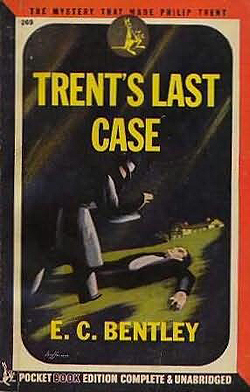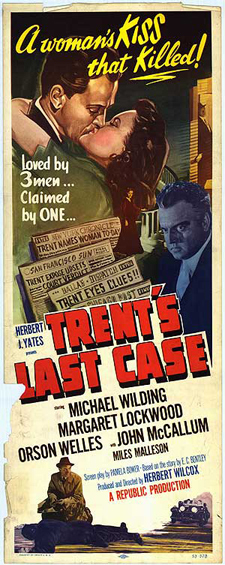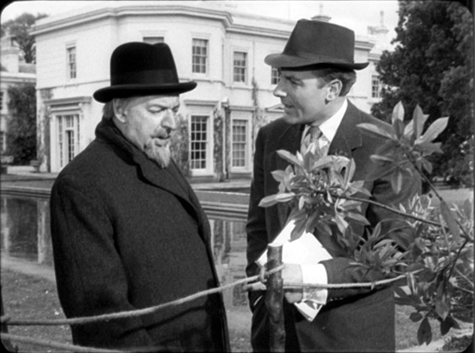 Funny how age changes your view of a book. I’m thinking specifically of Trent’s Last Case, the famous detective novel published in 1913 by E.C. Bentley, and how my view of it has flipped between two readings 35 years apart. As a teenager of 14 or 15, when I first read it, I knew enough about the history of detective fiction to know the book’s stature as a classic of the genre. Blurbs on the edition I owned proclaimed its greatness. There was Dorothy L. Sayers: “…a tale of unusual brilliance and charm, startlingly original” and there was Agatha Christie: “One of the three best detective stories ever written.” I’m sure I wondered what the other two best detective stories ever written were, but for G.K. Chesterton, competition with other mysteries wasn’t even an issue. Trent’s Last Case was, in his words, “the finest detective story of modern times.”
Funny how age changes your view of a book. I’m thinking specifically of Trent’s Last Case, the famous detective novel published in 1913 by E.C. Bentley, and how my view of it has flipped between two readings 35 years apart. As a teenager of 14 or 15, when I first read it, I knew enough about the history of detective fiction to know the book’s stature as a classic of the genre. Blurbs on the edition I owned proclaimed its greatness. There was Dorothy L. Sayers: “…a tale of unusual brilliance and charm, startlingly original” and there was Agatha Christie: “One of the three best detective stories ever written.” I’m sure I wondered what the other two best detective stories ever written were, but for G.K. Chesterton, competition with other mysteries wasn’t even an issue. Trent’s Last Case was, in his words, “the finest detective story of modern times.”
Quite a build-up, and I remember starting the novel with great excitement. It’s a short book and I read it through quickly. The amateur detective, Philip Trent, investigates the English country house murder of an American business tycoon. In the course of his inquiries Trent pokes around, questions servants, utters witticisms and generally comports himself with all the confidence of a great sleuth. He diligently analyzes clues and, like any self-respecting detective of the Golden Age, he explains his reasoning in little bits and pieces, tantalizing both the reader and those around him in the story. At what seems the novel’s climax, he reveals his solution, certain of course that he has solved the case. But in fact Trent has misread all the clues and the solution that he lays out is not the true one. Later, over a hearty dinner, Trent is told the real solution. The person who tells him this dissects his reasoning, laying out with utter clarity every point Trent got wrong. Trent listens with “the pallor of excitement” and while gulping a lot of wine. Though he tries to retain his usual spirit of good humor, Trent in essence is humiliated. It is then that we learn why this particular amateur detective has worked his last case.
And as a teenager reading, avid mystery fan though I was, I said, “Huh?”
I distinctly remember this feeling of puzzlement mixed with slight disappointment. I must’ve muttered something like, “That’s how it ends?” I felt that I had to be missing something. What were the mystery writer giants raving about? The book was readable, yes, and I hadn’t actually disliked it, but compared to Christie or Conan Doyle or John Dickson Carr or Ellery Queen, E.C. Bentley’s work was a letdown.
Now let’s cut to thirty-five years later.
I’m fifty at this point and I’ve been reading a lot of contemporary noir fiction. Just having finished a noir novel, I get the urge, I don’t know why, to read an old-fashioned detective tale. During my teen years, I read the Golden Age whodunits voraciously, but I seldom read them anymore. Nothing against them, but one or two brilliantly contrived puzzles a year is enough for me now.
So what to pick? I could read one I’ve never read but in fact it’s P.D. James and her book Talking About Detective Fiction that pushes me back toward Trent’s Last Case. In her superb overview of detective fiction, which I’d recently read, James discusses E.C. Bentley’s book. Without over-praising it, she points out its strengths, and she acknowledges its influential place in detective fiction history. I’m reminded of how it didn’t live up to the hype for me so many years ago. Should I give it a second chance? It’s been so long, I can’t remember the plot details. I certainly don’t remember who the killer is. It would almost be like reading the book for the first time. But this time I know more about the book’s background and that knowledge has created a context that may change how I regard Trent’s Last Case.

Answer: I did.
To begin with, the opening section describing the soon-to-be victim Sigsbee Manderson surprised me with its forthrightness. Its depiction of the Wall Street financier has a contemporary ring:
One who spoke the name of Manderson called up a vision of all that was broad-based and firm in the vast wealth of the United States. He planned great combinations of capital, drew together and centralized industries of continental scope, financed with unerring judgment the large designs of state or private enterprise. Many a time when he ‘took hold’ to smash a strike, or to federate the ownership of some great field of labor, he sent ruin upon a multitude of tiny homes; and if miners or steel-workers or cattlemen defied him and invoked disorder, he could be more lawless and ruthless than they. But this was done in the pursuit of legitimate business ends. Tens of thousands of the poor might curse his name, but the financier and the speculator execrated him no more. He stretched a hand to protect or to manipulate the power of wealth in every corner of the country.
Manderson has houses in the U.S. and England, and his murder in Britain, of course, is big news. Philip Trent is called onto the case by the uncle of Manderson’s widow, and the uncle completes the victim’s portrait:
I could only put it that one felt in the man a complete absence of the sympathetic faculty. There was nothing outwardly repellent about him. He was not ill-mannered, or vicious, or dull—indeed, he could be remarkably interesting. But I received the impression that there could be no human creature whom he would not sacrifice in the pursuit of his schemes, in his task of imposing his will upon the world.
The description of a cold, almost sociopathic businessman sounds especially modern, and it’s a sign that Bentley was eager to bring a piece of the real world into his mystery story. He is creating something more than an abstract puzzle with a cardboard-thin murder victim. Still, once we get to the descriptions of Trent, the tone lightens considerably.
“A painter and the son of a painter,” Trent is described as a man whose “best aid to success had been an unconscious power of getting himself liked.” He is a man usually in “good spirits” and with a “lively, humorous fancy.” Clearly this is no detective in the mode of Sherlock Holmes or Poe’s C. Auguste Dupin or any number of other moody, quirk-laden detectives of the period. But he is no mental lightweight either. Though not connected in any way to the police, he volunteers his services to them, on impulse, when he reads a newspaper account of a baffling crime. In dazzling fashion he gets results:
With nothing but the newspapers to guide him, he drew attention to the significance of certain apparently negligible facts, and ranged the evidence in such a manner as to throw grave suspicion upon a man who had presented himself as a witness.
The man is arrested and proven guilty. A few months later Trent delves into a case again, this time investigating as a freelance reporter. The newspaper editor who hires him butters him up when urging Trent to take the job:
“You could do it,” the editor had urged. “You can write good stuff, and you know how to talk to people, and I can teach you all of the technicalities of a reporter’s job in half an hour. And you have a head for a mystery; you have imagination and cool judgment along with it. Think how it would feel if you pulled it off.”
Considering it a lark to try, Trent accepts the offer, and sure enough he gives “the authorities a start and a beating” again. His name is on “all tongues.” It is no wonder that when he starts his work on the Manderson case, he thinks that it “might turn out to be terribly simple.” He’s a man riding high on a crest of success.

Never anything but oblivious to his own views, Trent hones in on a suspect and proceeds methodically to build a case against him. He pieces together his solution using logic and the evidence available. He marshals the clues in a coherent fashion. The reader is as sure as he is that he has the right man.
Near the end of the book Trent confronts that man (though politely, in the style of the time) and lays out his case. But of course the twist in Trent’s Last Case is that Trent is wrong, and it is precisely this twist, annoying to me when I read it as a fifteen-year-old, that I appreciated as a fifty-year-old. Appreciated and admired. “I am afraid I startled you,” Trent hears the real murderer say, and one can imagine how readers of the time were startled. Trent the man of perpetually high spirits breathes out “in a laugh wholly without merriment.” Not that contemporary readers will react with amazement; we’re accustomed to stories with fallible detectives and endings that reveal a bitter truth. For that matter, the tradition goes back to perhaps the very first “detective” story, Oedipus Rex. But in the realm of popular mystery fiction, Bentley without question did something innovative and unusual for his time, and what’s also true is that as a mystery genre reader I needed time and mystery reading experience to “get” it.
I don’t think Trent’s Last Case is one of the two or three greatest mystery novels ever written. I wouldn’t go that far. Readers now will find the mechanics of the crime somewhat convoluted (though this is par for the course in many a Golden Age mystery), and Bentley’s desire to create a fully human detective leads him down one questionable path: he has Trent fall in love with Manderson’s widow. The love angle plays an important part in the story, and while it does add to Trent’s richness as a character, it is handled with a gravity at odds with the lightness throughout the rest of the book. Though sometimes the reader is invited to chuckle at Trent (even when he gets the solution wrong) the love story is written in such a way that we’re supposed to take its outcome quite seriously. There is a slight inconsistency in tone here.
That said, anyone who likes Golden Age mysteries and who’s looking for a witty and diverting work from that period could do far worse than Trent’s Last Case. It is 100 years old this year, and it holds up well. You won’t find it as astounding as Bentley’s contemporaries did, but you’ll have an enjoyable, intriguing read and you’ll be reading one of the most influential detective novels ever written.
Scott Adlerberg lives in New York City. A film nut as well as a writer, he co-hosts the Word for Word Reel Talks film commentary series each summer at the HBO Bryant Park Summer Film Festival in Manhattan. He blogs about books, movies, and writing at Scott Adlerberg’s Mysterious Island. His Martinique-set crime novel, Spiders and Flies, is available now from Harvard Square editions at Amazon, B&N, and wherever books are sold.
